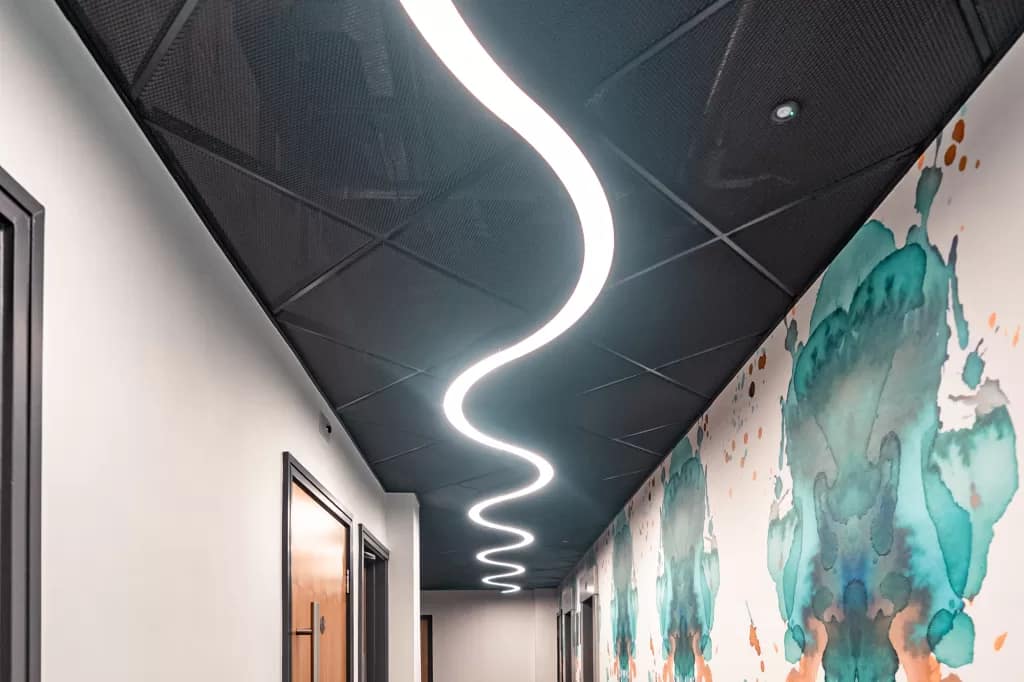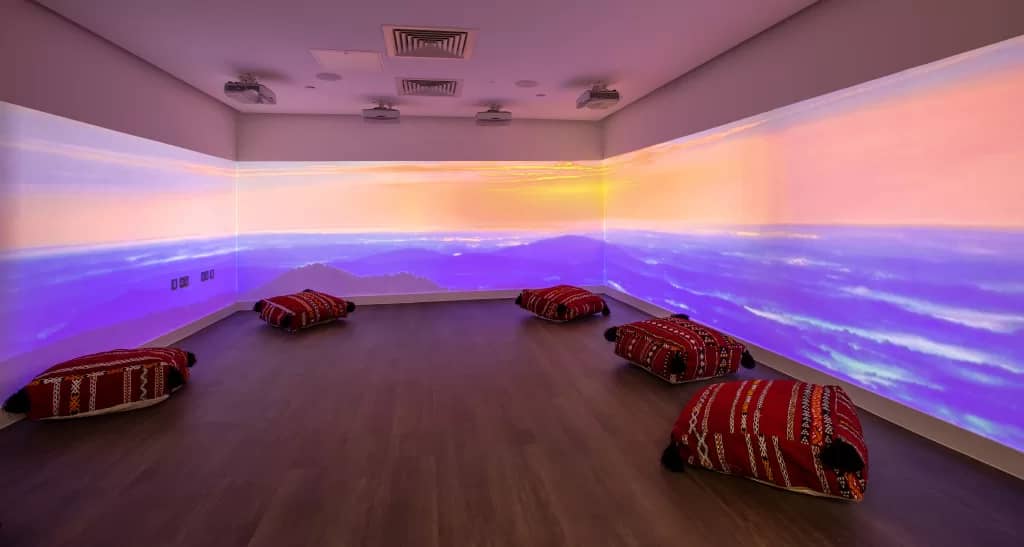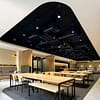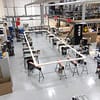Blog
A Guide to Lighting Different Areas of the Workplace
Lighting plays a crucial role in any office environment, not only in enhancing productivity but also in creating a comfortable and conducive workspace. In the United Kingdom, the Society of Light and Lighting (SLL), a part of the Chartered Institution of Building Services Engineers (CIBSE), provides comprehensive guidelines and regulations regarding office lighting design. In this guide, we will delve into the various areas of an office space, including working areas, reception, meeting rooms, corridors, and washrooms, and explore the best practices for illuminating these spaces in compliance with UK standards.
Lighting Working Areas
Efficient lighting in working areas is paramount for ensuring employee well-being and productivity. According to CIBSE guidelines, the recommended illuminance level for general office tasks is between 300 and 500 lux. This can be achieved through a combination of natural light, overhead lighting fixtures, and task lighting.
Incorporating daylight harvesting techniques, such as strategically placing workstations near windows to maximise natural light, can help reduce the reliance on artificial lighting during daylight hours. Additionally, adjustable task lighting allows employees to personalise their lighting preferences, reducing eye strain and fatigue.
When selecting lighting fixtures for working areas, it’s essential to consider factors such as glare, colour rendering index (CRI), and uniformity of light distribution. LED linear lighting solutions are often preferred for their energy efficiency and ability to provide consistent illumination without flickering.
Reception Area Lighting
The reception area serves as the first point of contact for visitors, making it imperative to create a welcoming and professional ambience. CIBSE recommends an illuminance level of 200 lux for reception areas. Lighting fixtures should be chosen to complement the overall design aesthetic while ensuring adequate brightness for tasks such as reading documents and greeting visitors.
Indirect lighting, such as wall sconces or recessed fixtures, can help create a warm and inviting atmosphere without causing glare or discomfort. Accent lighting can be used to highlight architectural features or branding elements, further enhancing the visual appeal of the reception area.

Lighting Meeting Rooms
Effective lighting in meeting rooms is essential for facilitating communication and collaboration among participants. CIBSE suggests an illuminance level of 500 lux for meeting rooms, with additional considerations for presentation areas and video conferencing.
A combination of ambient, task, and accent lighting can be utilised to accommodate various activities conducted in meeting rooms. Dimmable lighting controls allow for flexibility in adjusting light levels according to the specific requirements of each meeting.

Corridor lighting
While corridors may not be primary workspaces, proper lighting is still crucial for ensuring safety and wayfinding within the office environment. CIBSE recommends an illuminance level of 100 lux for corridors, with uniform distribution to prevent shadowing and glare.
Wall-mounted or ceiling-mounted fixtures with wide beam angles are ideal for illuminating corridors efficiently. Motion sensors can be integrated into lighting controls to minimise energy consumption when areas are not in use.

Washrooms
Lighting in washrooms serves dual purposes: providing adequate illumination for tasks such as handwashing and maintaining a safe and comfortable environment. CIBSE recommends an illuminance level of 200 lux for washrooms, with higher levels required for task areas such as mirrors and sinks.
Waterproof and vandal-resistant fixtures are essential for washroom environments to ensure durability and safety. LED luminaires with high colour rendering properties are preferred to accurately render skin tones and enhance visibility.

Lighting Break Space
Break rooms and staff lounges serve as retreats for employees to unwind, socialise, and recharge during breaks. These spaces benefit from a combination of ambient and task lighting to create a relaxed and inviting atmosphere. Soft, diffused lighting helps create a sense of comfort and relaxation, encouraging employees to take a break from their workstations. Adjustable lighting controls allow for flexibility, accommodating various activities such as reading, chatting, or enjoying a quick snack. By incorporating lighting that fosters a sense of well-being, break rooms and staff lounges become more than just functional areas—they become integral to promoting employee satisfaction and morale within the workplace.
Office Kitchen Lighting
The kitchen or cafeteria is a hub of activity where employees gather to prepare meals, dine together, and take a well-deserved break. Lighting in these spaces plays a crucial role in supporting food preparation, enhancing safety, and creating a pleasant dining experience. Bright, uniform lighting is essential for ensuring visibility and cleanliness in food preparation areas, reducing the risk of accidents and promoting hygiene. Pendant lights or suspended fixtures over dining tables can create a cosy atmosphere, encouraging social interaction and camaraderie among employees during meal times. Additionally, daylighting strategies such as strategically placed windows or skylights can help supplement artificial lighting, creating a brighter and more inviting environment. By integrating lighting solutions that prioritise both functionality and comfort, the kitchen or cafeteria becomes a welcoming space where employees can recharge and connect with their colleagues.

Storage Areas
Functional lighting is indispensable in storage areas, where efficient inventory management and equipment maintenance are paramount. LED fixtures, renowned for their energy efficiency and longevity, are the ideal choice for illuminating these spaces, providing bright and consistent light to aid in the retrieval and organisation of items. Additionally, motion sensors can be integrated into lighting systems to optimise energy usage by automatically dimming or turning off lights when the area is unoccupied. By leveraging LED fixtures and motion sensors, storage areas not only enhance operational efficiency but also contribute to sustainability efforts by minimising energy consumption and reducing operational costs.
Print/Copy Rooms
Print and copy rooms are bustling hubs of activity where accurate document handling is essential. Adequate task lighting is crucial in these spaces to ensure employees can read and process documents with precision and clarity. Bright, focused lighting fixtures positioned above workstations and printing equipment minimise eyestrain and enhance visibility, thereby improving overall productivity. Furthermore, ambient lighting plays a vital role in enhancing general visibility and safety within the room, reducing the risk of accidents and promoting a comfortable working environment. By combining task and ambient lighting, print/copy rooms optimise efficiency and ensure that document handling tasks are performed accurately and efficiently.
Lighting Wellness Rooms
Quiet rooms and wellness areas serve as sanctuaries within the office environment, providing employees with a tranquil space to unwind, recharge, and prioritise their well-being. Soft, adjustable lighting is essential in these designated areas, as it fosters relaxation and stress relief. Dimmable fixtures allow individuals to customise the lighting ambience according to their preferences, creating a serene environment conducive to meditation, reflection, or relaxation exercises. By incorporating adjustable lighting solutions, quiet rooms and wellness areas empower employees to manage their stress levels effectively and maintain a healthy work-life balance.

Breakout Space Lighting
Collaborative spaces, such as breakout areas and project rooms, are dynamic environments where creativity and teamwork thrive. Lighting design in these spaces is crucial for fostering collaboration and innovation among employees. Adjustable lighting options cater to diverse activities, allowing teams to tailor the lighting ambiance to suit their specific needs. Bright, energising lighting promotes focus and productivity during brainstorming sessions or collaborative projects, while softer lighting encourages relaxation and camaraderie during informal discussions or team-building activities. By providing flexible lighting solutions, collaborative spaces inspire creativity, boost morale, and enhance teamwork, driving success and innovation within the organisation.
Regulatory Compliance
In the UK, office lighting design must adhere to various regulations and guidelines, including those outlined by CIBSE and building regulations such as Part L of the Building Regulations. These regulations aim to promote energy efficiency, occupant comfort, and visual performance while minimising environmental impact.
Designing an effective lighting scheme for different areas of a UK office requires careful consideration of illuminance levels, lighting fixtures, and regulatory compliance. By following CIBSE guidelines and integrating energy-efficient lighting solutions, businesses can create a workspace that enhances productivity, promotes well-being, and meets the needs of employees and visitors alike.



